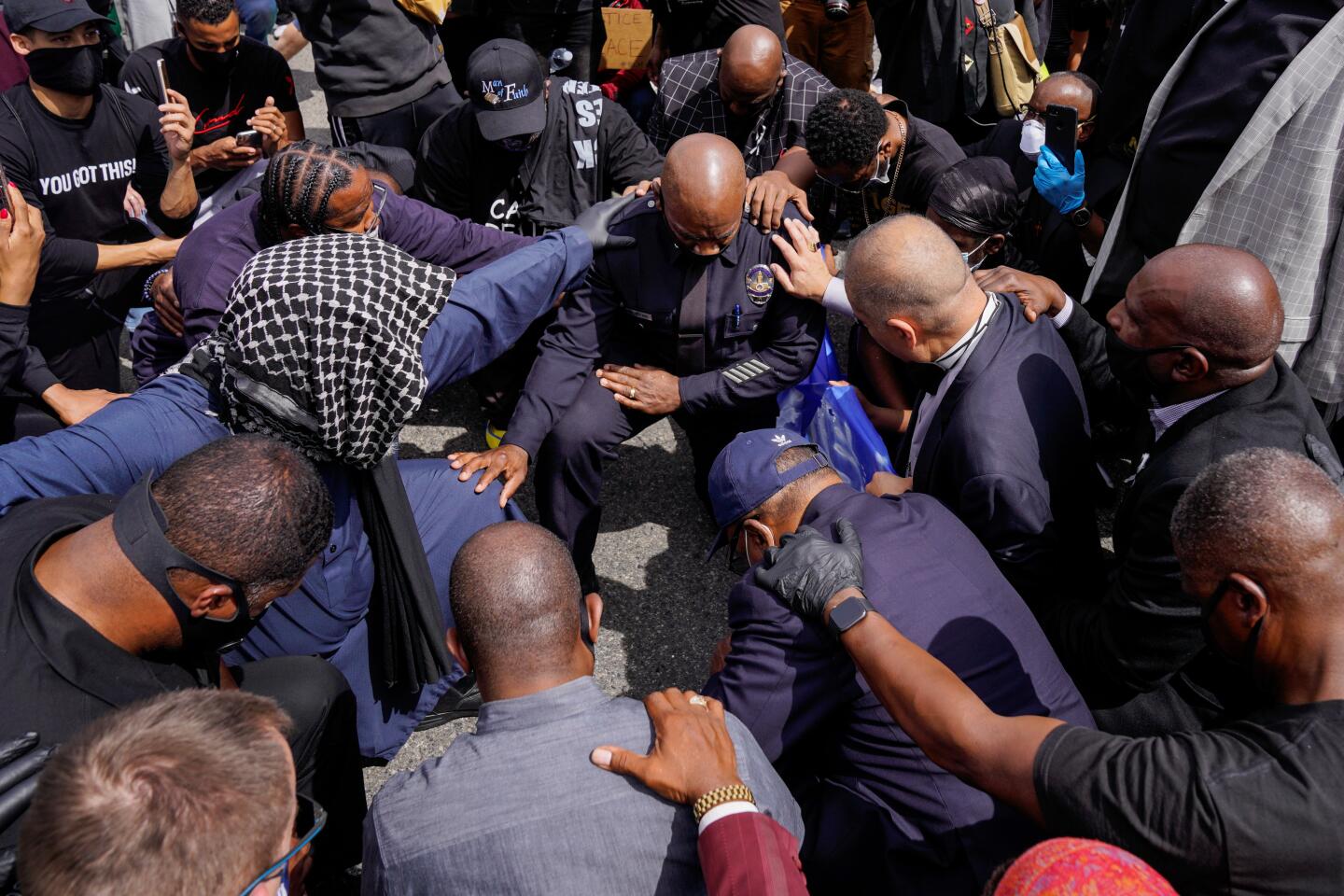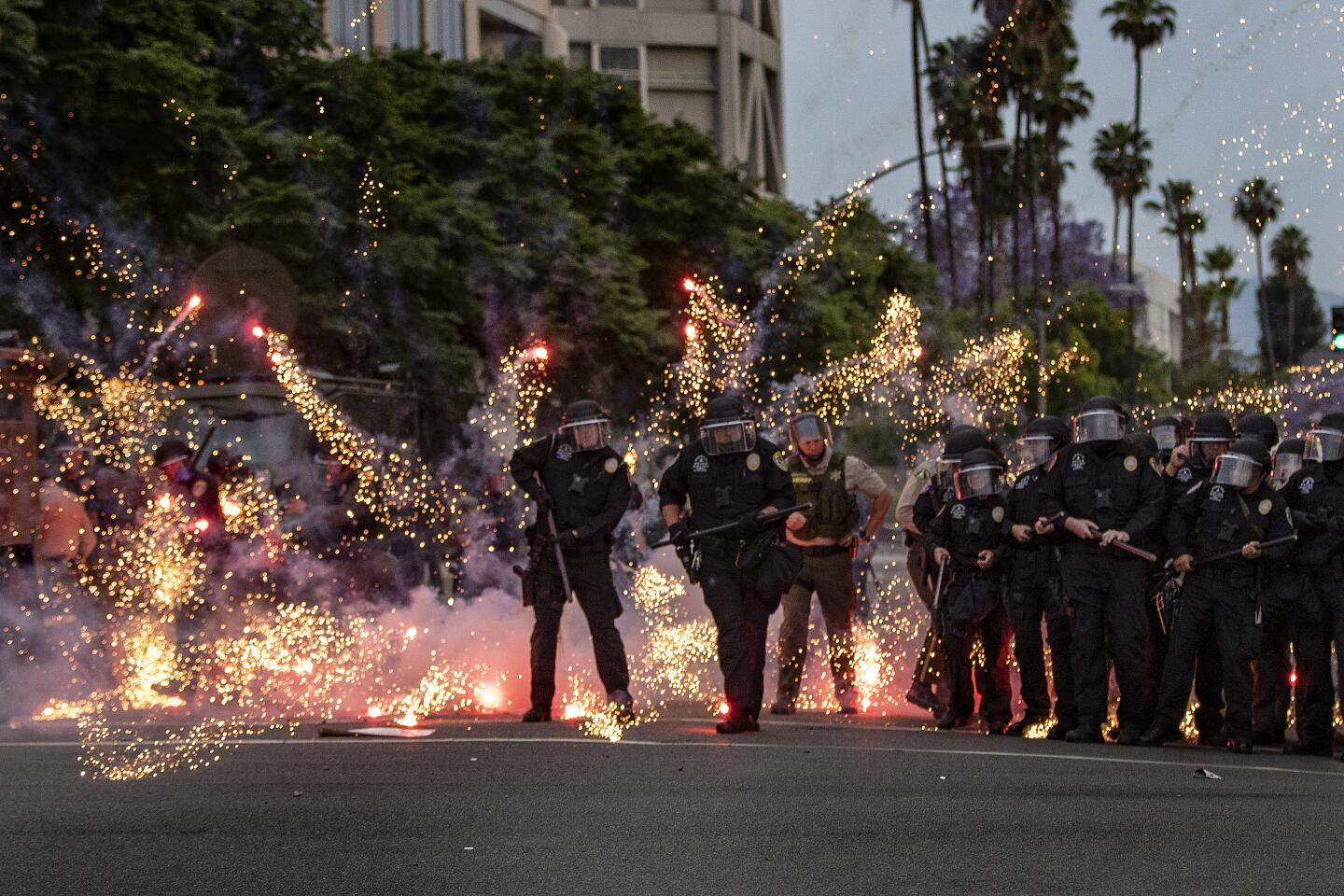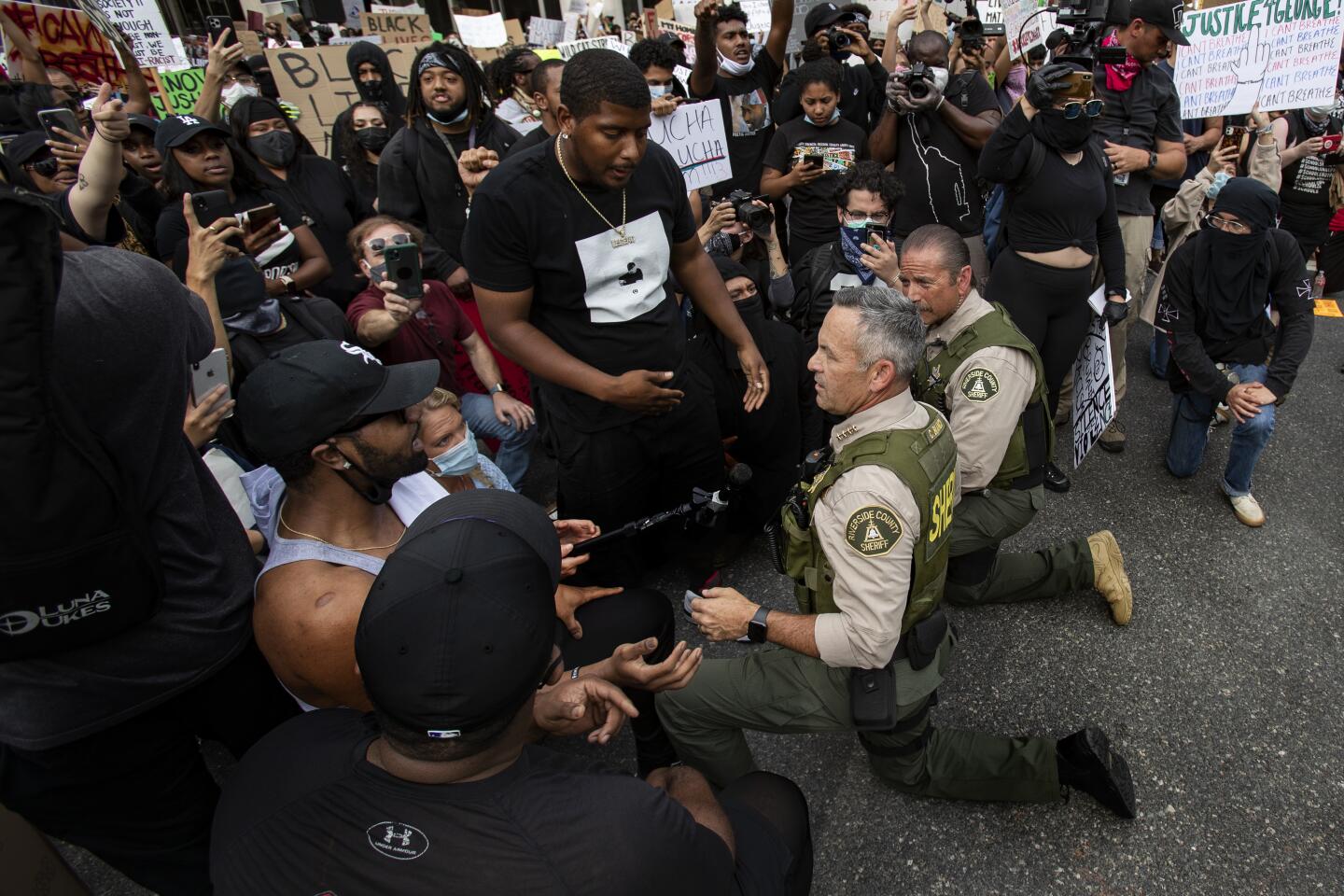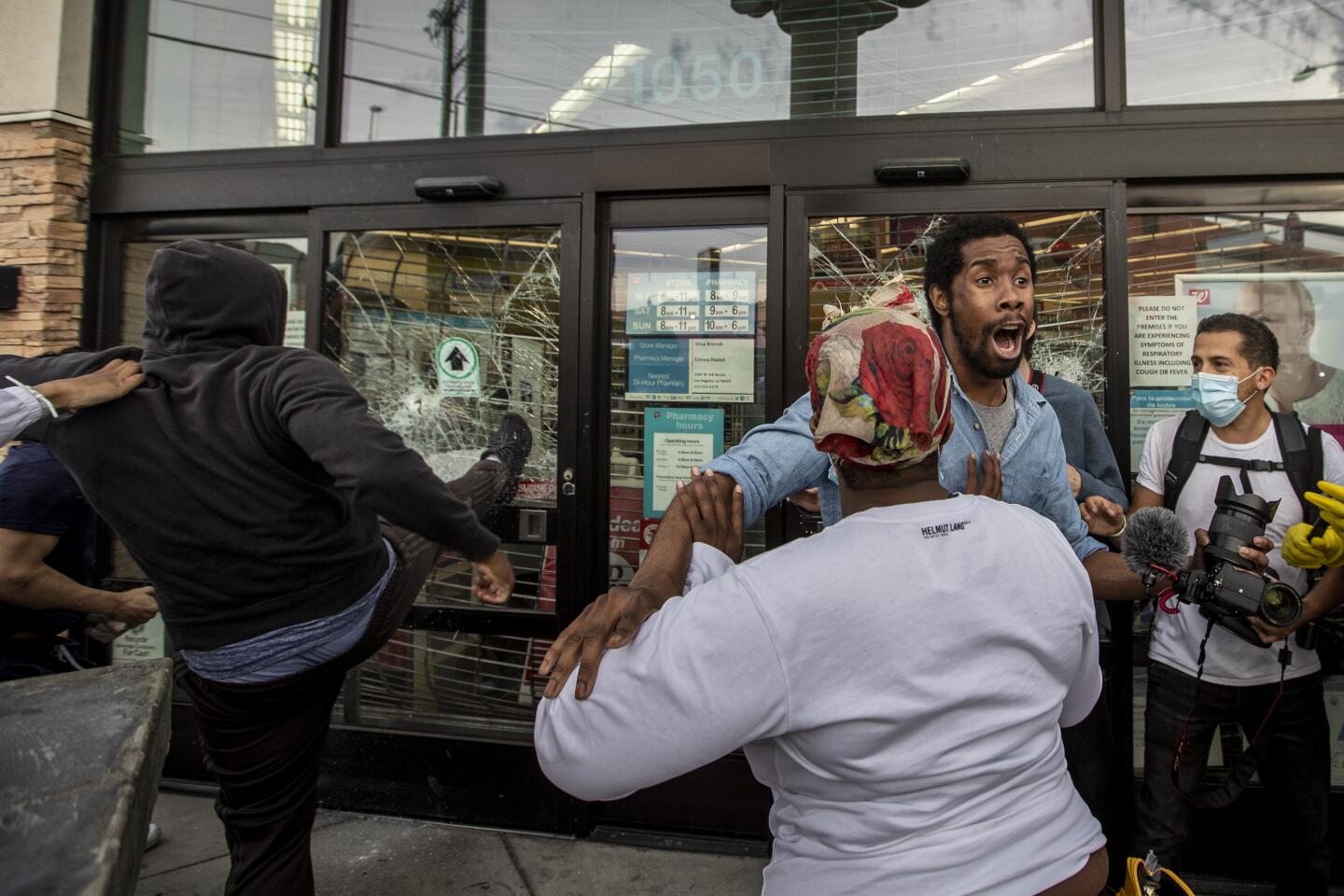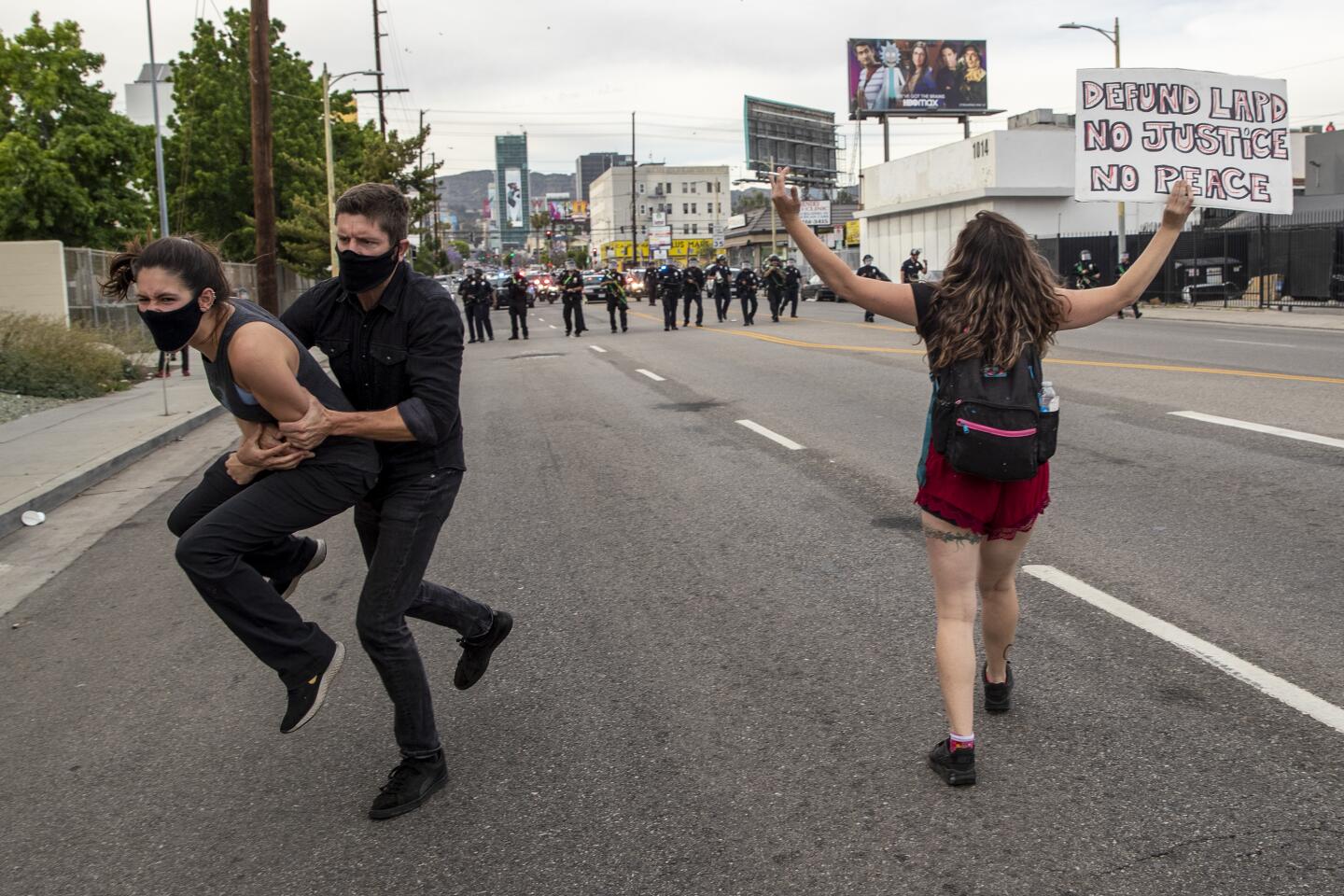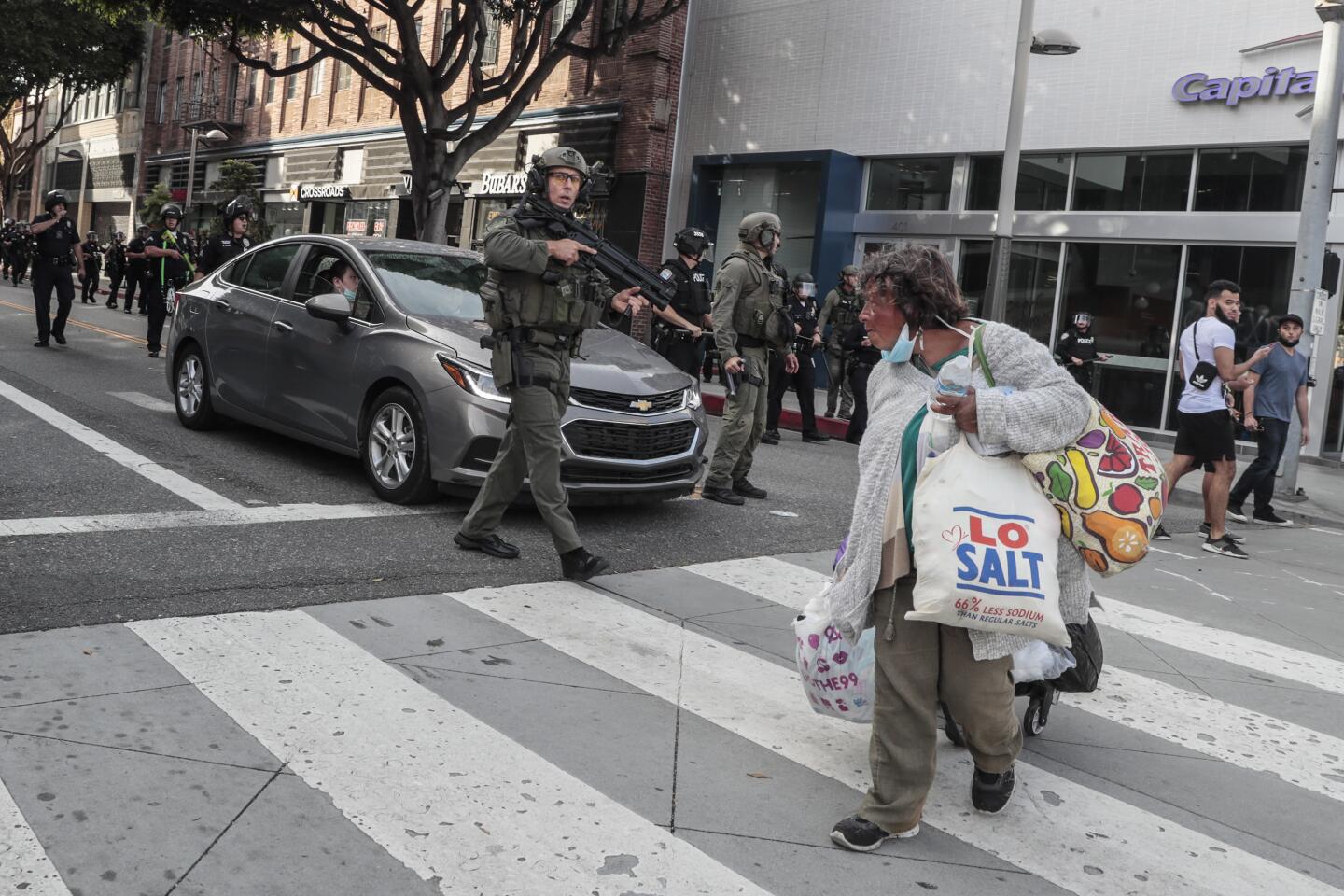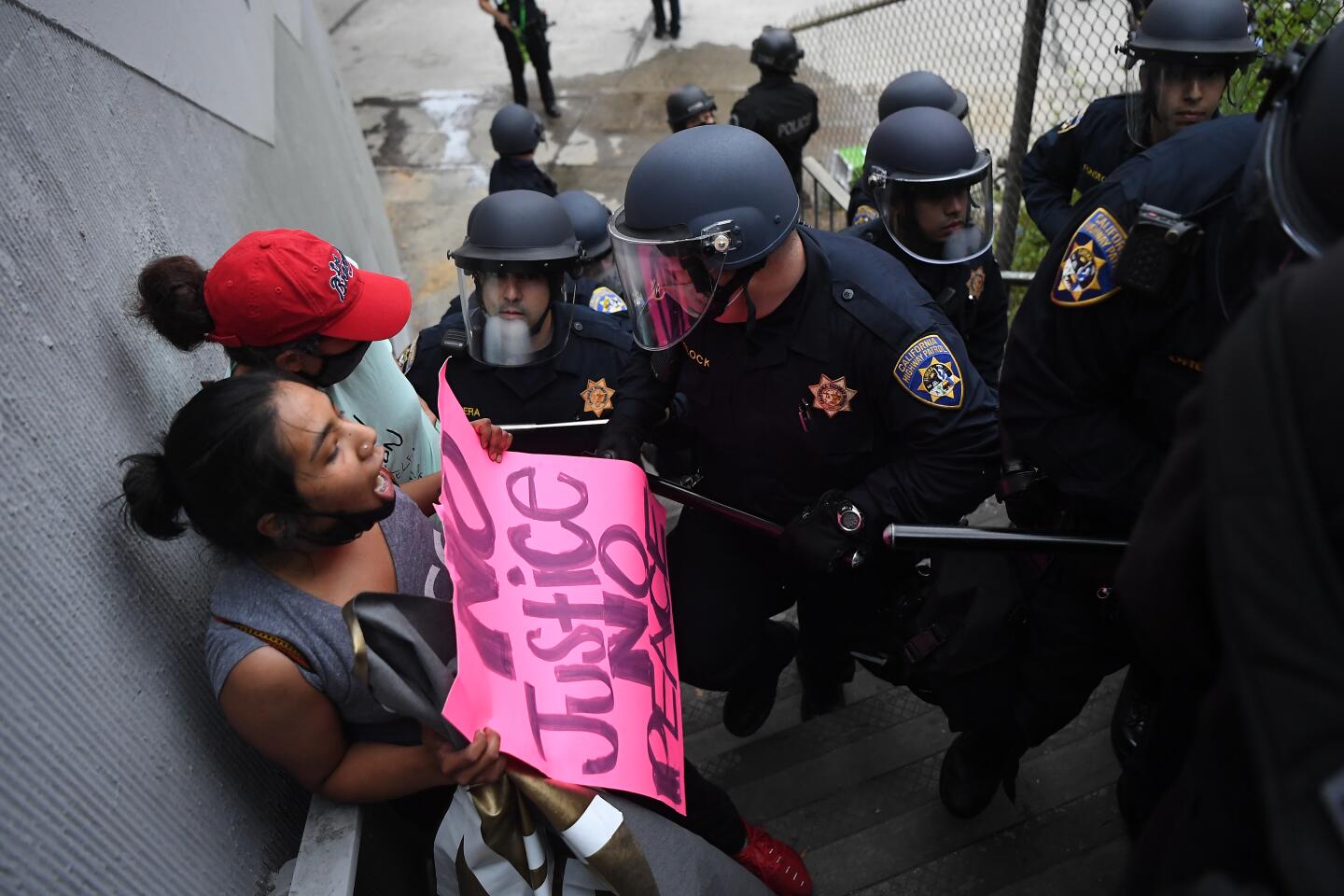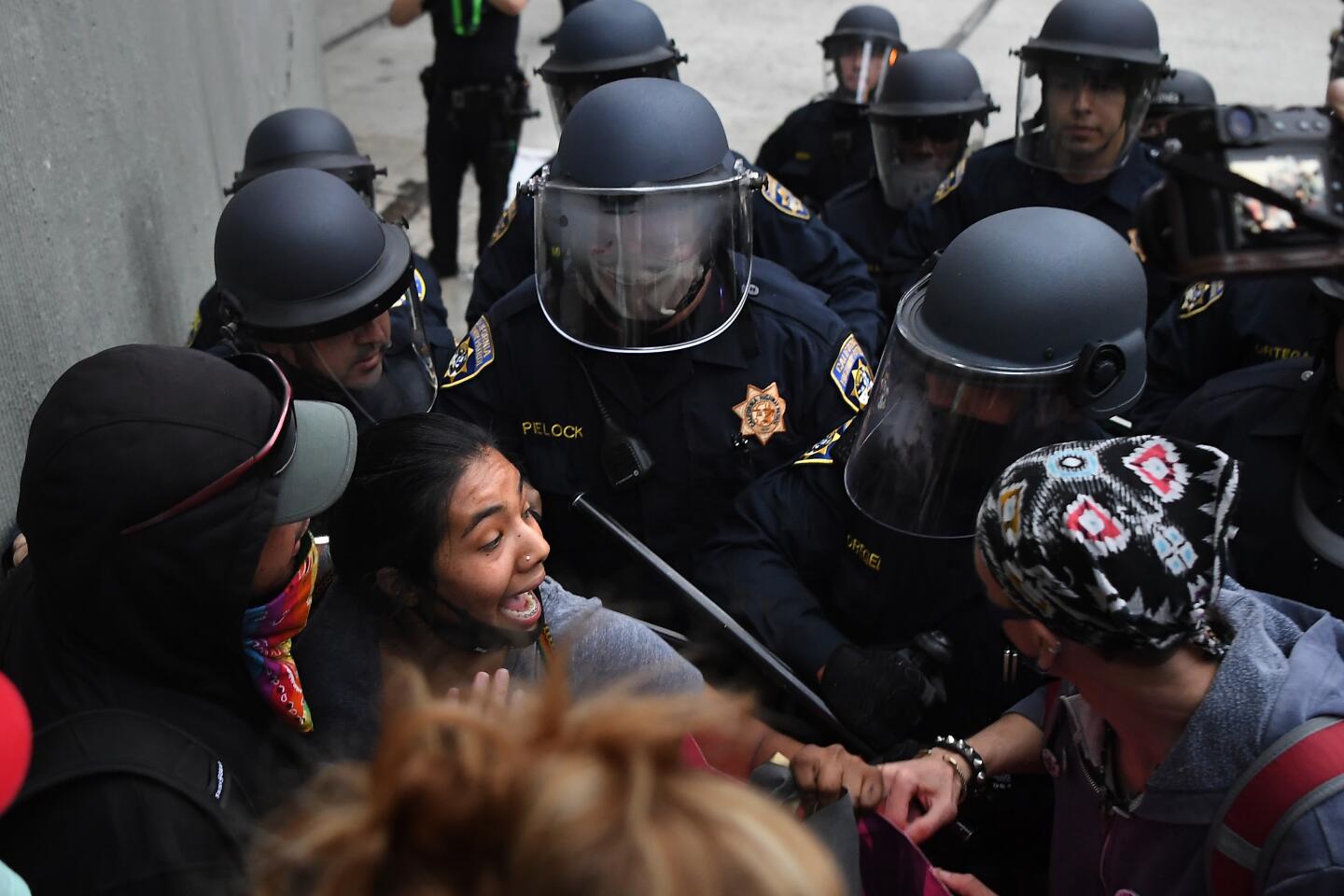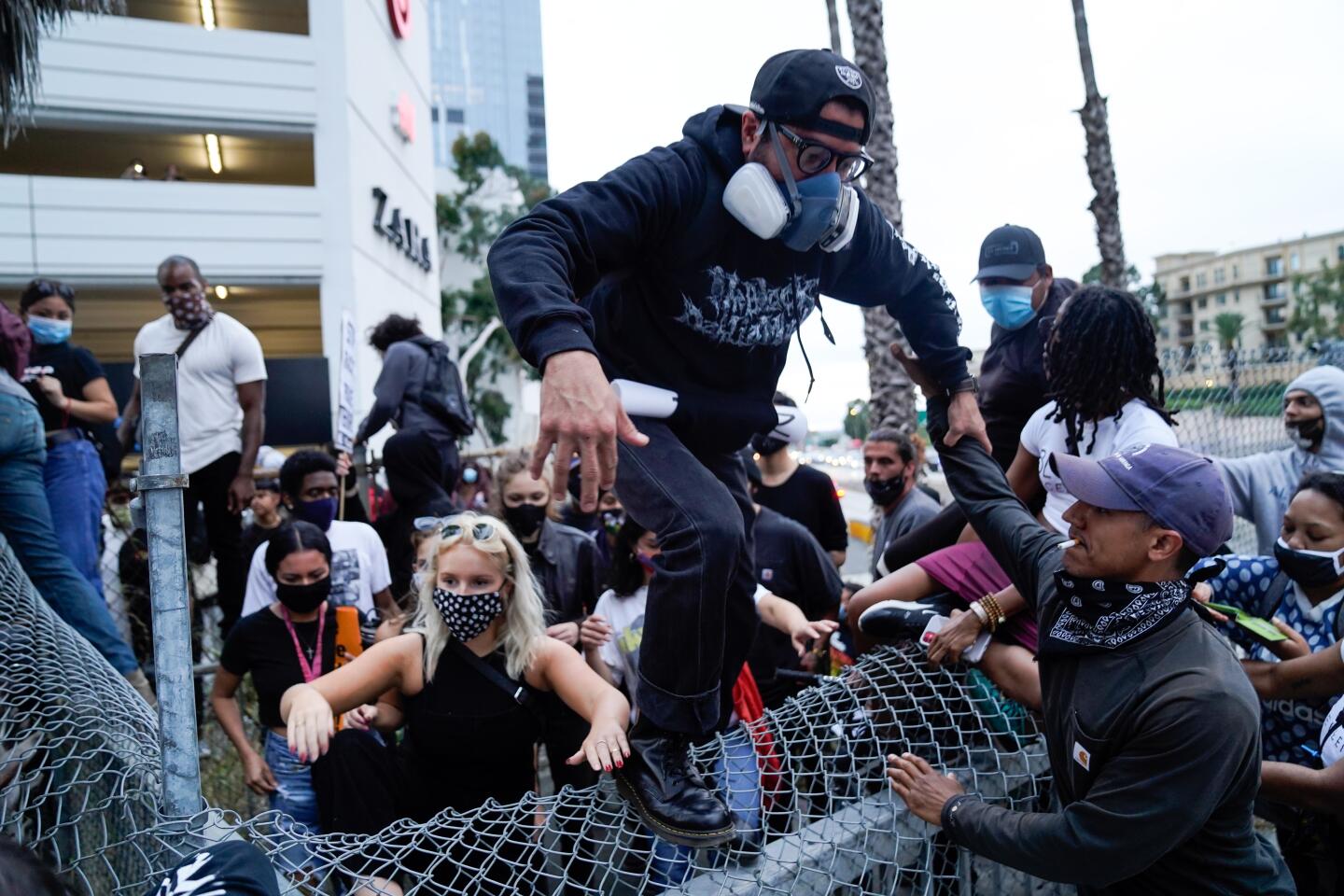Trump calls for ‘law and order,’ threatens to deploy troops to major cities

- Share via
WASHINGTON — President Trump, declaring himself a “president of law and order,” threatened Monday to deploy “thousands and thousands of heavily armed soldiers, military personnel and law enforcement officers” to American cities, claiming governors and local officials had “failed to take necessary action” to end civil unrest.
“These are not acts of peaceful protest,” Trump declared during a brief speech in the White House Rose Garden, referring to the demonstrations and sometimes violent acts that have broken out in dozens of major cities. “These are acts of domestic terror.”
He called himself an ally of legitimate protesters, blaming violence and looting on “anarchists.”
Even as he did so, however, police and National Guard units — some on horseback — fired rubber bullets, flash-bang grenades and tear gas canisters into peaceful crowds across the street from the White House. Reporters in the Rose Garden where he spoke could hear booms in the background as Lafayette Park was cleared.
The provocative show of force seemed geared toward allowing a photo opportunity in which Trump, directly after addressing the nation, walked across the park amid a phalanx of Secret Service agents, armored military and law enforcement officials to St. John’s Episcopal Church, where a fire had been set the previous night.
Police stood guard on deserted streets, and helicopters buzzed overhead.
Trump then stood in front of the church holding a Bible as photographers snapped pictures and the president summoned top officials — including Atty. Gen. William Barr, Defense Secretary Mark Esper and Chief of Staff Mark Meadows — to pose with him.
The posed photo and the official violence that preceded them drew outrage from the church’s bishop and from Democratic officials.
“They used the American military to push back a peaceful protest ... just so he could have a photo op,” New York Gov. Andrew Cuomo said on CNN. “When was the last time you saw the American military called out against American citizens?”
The Right Rev. Mariann Budde, bishop of the Episcopal Diocese of Washington, called the walk to the church “an outrage.”
“An incendiary moment,” said Illinois Gov. J.B. Pritzker, another Democrat.
Oregon Sen. Ron Wyden went a step further, posting a message on Twitter in which he called Trump’s remarks a “fascist speech” that “verged on a declaration of war against American citizens.”
Trump laced his remarks with militaristic language, urging state and local officials to “dominate the street” and backing those requests by threat.
“If a city or state refuses to take the actions necessary to defend the life and property of the residents, I will deploy the United States military and quickly solve the problem for them,” he said.
Biden likens Trump to violent segregationists in response to George Floyd protests, decries gassing of demonstrators for a church ‘photo-op.’
Although Trump did deploy troops in and around Washington, where the federal government has direct authority, his ability to use troops more widely over the objections of state officials would raise a host of legal and practical questions that he ignored in his short, aggressive, remarks.
Pentagon officials noted that Trump had not actually invoked the 19th century Insurrection Act, which allows a president in some circumstances to deploy military personnel for domestic law enforcement.
The last time that was done was in Los Angeles during the 1992 civil unrest that followed the acquittal of police officers on charges of beating motorist Rodney King. In that case, the federal government acted at the request of then-Gov. Pete Wilson.
Without a state’s approval, the president’s ability to use troops domestically is sharply limited by law, although the prohibitions do have exceptions Trump might try to exploit.
Trump’s new posture came after 48 hours in which he had been mostly silent in public, except for his angry Twitter finger.
In private, however, during a call with governors Monday, a few hours before his announcement, the president repeatedly pushed for a harsher crackdown.
“Most of you are weak,” Trump said, berating the governors and urging them to “dominate” the protesters, according to a person on the call. He urged state officials to track down lawbreakers and send them to prison for five to 10 years.
A second person with knowledge of the call described the president as “bellicose,” raising the possibility of military action and describing the situation as a war. The message was echoed by Esper, who described the need to “dominate the battle space,” language normally used to describe far-flung conflict zones instead of American streets.
The law does allow a president to send troops to a state over the state government’s objections, but only under specific circumstances.
The president’s comments stunned state leaders who have been struggling to defuse tensions.
“I know I should be surprised when I hear incendiary words like this from him, but I’m not,” Massachusetts Gov. Charlie Baker, a moderate Republican, said at a briefing after the call.
“At so many times during these past several weeks, when the country needed compassion and leadership the most, he was simply nowhere to be found. Instead, we got bitterness, combativeness and self-interest.”
Minnesota Gov. Tim Walz, a Democrat, told reporters that he “thanked” Trump for his input but made clear he disagreed.
“A posture of a force on the ground is unsustainable militarily, it’s unsustainable socially because it’s the antithesis of how we live,” he said.
Walz took issue with Trump’s claim that “the world is laughing” at the urban uprisings across America.
“Nobody’s laughing here,” he said. “We’re in pain, we’re crying.”
Trump’s remarks made clear that he has no intention of pursuing the role of national healer that past presidents have often assumed during moments of unrest. It’s a role at which many in both parties agreed he would not be likely to succeed.
Voter dissatisfaction with Trump’s pandemic response puts him on defense in Iowa, a state he won by a wide margin in 2016
Even the White House has tacitly conceded that point, downplaying the utility of a presidential speech as a tool for generating calm.
“Continual statements, as he’s made day and day and day again, they don’t stop anarchy. What stops anarchy is action, and that’s what the president is working on right now,” Trump’s press secretary, Kayleigh McEnany, said during a news briefing Monday at which she invoked the amorphous left-wing movement “antifa” — a contraction of antifascist — which the White House has sought to blame for violent protests.
Republican Sen. John Thune of South Dakota, a member of his party’s Senate leadership, offered dismissively faint praise Monday afternoon.
“The country is looking for healing and calm. And I think the president needs to project that in his tone,” Thune said. “He masters that sometimes.”
The view was harsher from Trump’s critics:
“There’s an overwhelming body of evidence out there about how incapable most Americans think he is of handling a moment like this, someone whose whole entire political predicate was based on division,” said Cornell Belcher, formerly a pollster for Barack Obama. “How, in a moment when we need a unified voice, can he step in and lead? He can’t.”
On Friday night, Trump was whisked into the underground bunker at the White House as skirmishes intensified just outside the gates, according to an administration official speaking on the condition of anonymity. He has been holed up in the White House since Saturday night, remaining out of sight as some buildings near its perimeter burned.
Over the last 48 hours, as police and rioters continued to clash just a few hundred feet from his residence, he continued to tweet as though he were a bystander, attacking the media and left-wing groups he selectively blamed for the violence.
Trump’s use of strongman tactics to discredit U.S. elections, spreading confusion with false claims, is having a dangerously corrosive effect.
The contrast between Trump and his predecessors became even clearer when Obama on Monday released an essay titled “How to Make This Moment the Turning Point for Real Change,” which offered support, advice and hope for the protesters while denouncing “the small minority of folks who’ve resorted to violence in various forms.”
“We’ve had three years of pot-stirring from the White House,” said Timothy Naftali, a historian and former director of the Richard Nixon Presidential Library and Museum.
“His go-to has always been to stir anger, to highlight and inflame, and he did it with glee and for political gain and because he just likes to do it.”
Those qualities, while troubling to many Americans, mattered less politically before the explosion of problems during the fourth year of Trump’s term.
“Imagine you are in Trump’s shoes, you have been dealing with the virus, you’ve been dealing with the economy, and you’ve been dealing with China, and then suddenly there’s this whole eruption,” said Newt Gingrich, the former Republican House speaker and a Trump ally. “You’re trying to wrap your head around this.”
Gingrich said he does not see the president’s role as a healer. Instead, he advocated for Trump to define a “civil war” between people who want “to destroy the country” and those who want to keep it.
“It’s not going to calm things because the people you’re up against don’t want to calm anything,” said Gingrich, who went on the president’s favorite TV program, “Fox & Friends,” on Monday to push the idea.
Times staff writers David Cloud and Jennifer Haberkorn in Washington and Molly O’Toole in Minneapolis contributed to this report.
More to Read
Sign up for Essential California
The most important California stories and recommendations in your inbox every morning.
You may occasionally receive promotional content from the Los Angeles Times.






